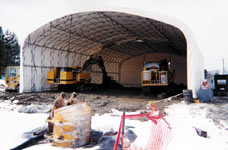|
CBA
Environmental Services, Inc
|
Corporate
Profile | Project Case Studies
| Chlorinated Solvent Soil Remediation
Statement of Qualifications | MITU
Technology | Biosolids - M-Sec Technology
Pesticide Impacted Land Redevelopment | Training
& Other Services | Contact Us
| Home
VOC and Metals Soil Remediation
Arcade, New York
Client: HSI Geotrans/Motorola, Inc.
Click Here to Download this Case Study in PDF Format
SITUATION
A chemical and waste storage building was the source of contamination at a former Motorola facility near Buffalo, New York. An Interim Remedial Measure (IRM) was developed to address the heavy metal and VOC impacted soils remaining at the currently active facility now owned by Prestolite Electric, Inc. The VOC contamination included BTEX and TCE, while the metal contamination included primarily cadmium but also elevated levels of chromium and lead. The contamination extended to a depth of 12 feet and encompassed a volume of approximately 4,500 cubic yards.
Several alternative remedial options were tested and evaluated at the site; they included soil vapor extraction and phytoremediation. These approaches were unsuccessful due to the lithology and characteristics of the site soils. As part of the IRM, and as a voluntarily negotiated Order of Consent, a Remedial Action Plan (RAP) was submitted to the New York State Department of Environmental Conservation (NYSDEC) and approved proposing the use of the MITU technology to remediate VOC and metals impacted soils.
CBA's TECHNOLOGY AND APPROACH
Motorola's consultant HSI Geotrans awarded the remediation contract to CBA through a competitive bidding process. The MITU technology was selected based on total cost and on the MITU's ability to treat soils contaminated with mixed waste (e.g. metals and VOCs). CBA proposed forced hot air and mechanical mixing for the thermal stripping and removal of VOCs and admixing of a chemical reagent for the stabilization of heavy metals. The most appealing aspect of this approach was that the MITU could perform both remedial processes simultaneously or as a parallel or serial technique utilizing one of more MITUs.
RESULTS
Treatment goals were established for the following volatile organic compounds; TCE - 0.7ppm, toluene - 1.5ppm, ethyl benzene - 5.5ppm, and xylene - 1.2ppm. The objective for metals treatment was to minimize the potential leachability with TCLP values for cadmium, chromium, and lead approaching or meeting the NYSDEC groundwater standard. During the treatment process subsurface debris in the form of concrete, as large as 14 ft x 4 ft x 4ft; asphalt; wood and timber; crushed and in tact drum carcasses; metal pipes, plastic and geofabric material, was discovered. A perched water table was also encountered throughout the treatment area at depths as shallow as 3 feet.
In-situ treatment with the MITU began in December and was conducted throughout the winter months. A temporary portable structure was erected to facilitate working through the severe climate in this region.
The cleanup goals for all heavy metals and for TCE, toluene, and ethyl benzene were met or exceeded. Although the cleanup goal of 1.2ppm for xylene was not met in nineteen of thirty-one treatment grids; A xylene mass removal of at least 87% was obtained throughout the treatment area. In addition, a 96% reduction was achieved in twelve of the nineteen grids and a reduction in excess of 99% was shown in four of those grids. Based on these results, the Client was able to obtain closure.
Project Manager: Clark A. Romberger
Site Manager: Donald Chescavage
Bid Cost: $500,000
Client Contact Reference: Michael E. Loch, Motorola (847) 480-8000
HSI Project Manager: Rich Gnat (262) 792-1282
© 2001-2005, CBA Environmental Services, Inc.
